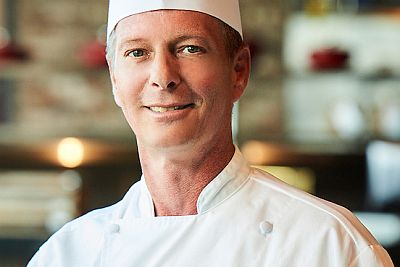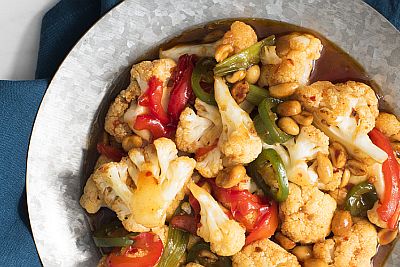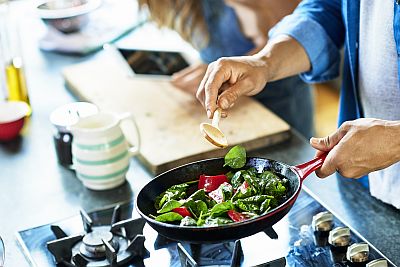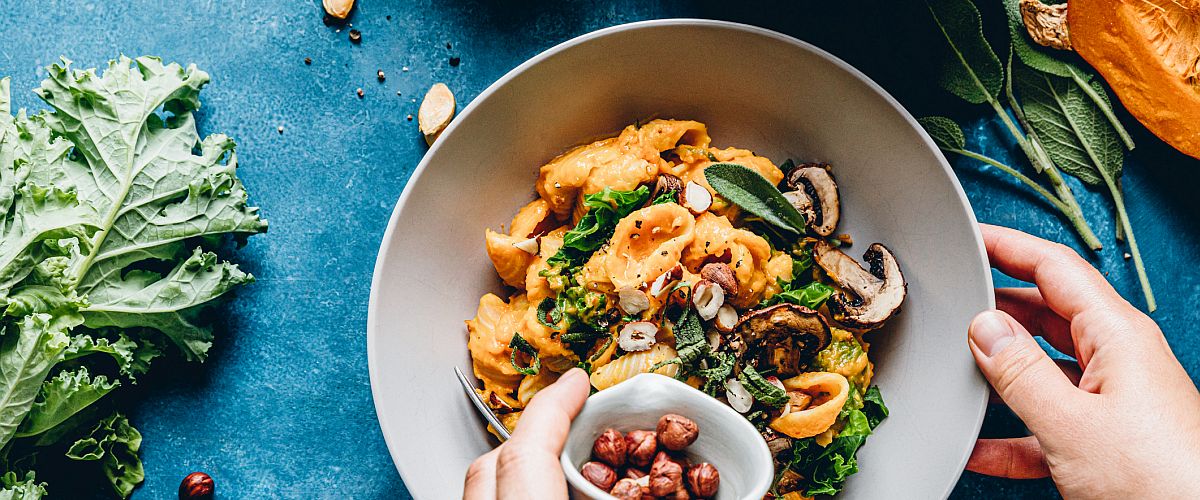If you’ve never really cooked before, it’s easy to be intimidated in the kitchen. You might envision your grandmother’s specialties or the mouthwatering food photography on Instagram and think, “I can’t possibly make that at home!” Or maybe you’ve pledged to simply eat healthier or spend less money on eating out or delivery, and you don’t know where to start.

Chef Scott Zahren
The truth is cooking at home doesn’t have to be hard. You can create delicious, healthy meals for yourself and your family. You just need a few culinary building blocks to boost your confidence. To set you up for success, we tapped the experience of Chef Scott Zahren, Director of Culinary Development. Whether you’re a true novice in the kitchen or just want to get out of a cooking rut, here are his tips to help you overcome your food fears and get cooking.
1. Keep it simple.
OK, reality check: Cooking healthy meals at home does take more effort than ordering takeout. But don’t let an all-or-nothing mindset keep you from trying new things in the kitchen. The key is to start small—that is, try one new ingredient, dish, or cooking technique at a time, advises Chef Scott.
If you’re used to frozen or canned veggies like green beans, for instance, try cooking them yourself. Select fresh beans at the store, then wash, trim, and steam them on the stovetop or in the microwave.
“It’s more work, but you’ll also start to appreciate how much better they taste,” Chef Scott says.
The same keep it simple approach applies to learning new cooking methods. Chef Scott recommends that new or aspiring home cooks work on one new skill at a time. Spend a month getting comfortable stir-frying before you move on to oven-roasting and other skills.
Once each skill becomes comfortable, graduate to something else. Feel free to take shortcuts in the meantime. For example, if you’re hosting your first dinner party for friends, focus on making the main course and let them bring the appetizer, sides, or dessert.
2. Find your recipe inspiration.
With a well-rounded recipe repertoire, you will always have a good starting point, whether it’s a special occasion or an average Wednesday night. But how do you build up your recipe collection?
Long, complex recipes can be daunting, so Chef Scott suggests starting with those that require fewer ingredients and steps. From there, assemble recipes you know and love, whether it’s a go-to restaurant meal (Google it!) or a family favorite.
If those beloved dishes could stand to be a little healthier, Chef Scott recommends going plant-forward by replacing some or all the animal protein with vegetables, beans, or legumes.
And remember the Feed Your Potential 365 recipe section is a fabulous source for fresh food inspiration, and we add new recipes all the time!
3. Try a one-dish meal.

Get the Recipe: Kung Pao Cauliflower
In the spirit of keeping it simple, one-dish meals have great appeal for aspiring home cooks. Not only do these recipes tend to be easy and convenient, they require less clean up afterward. You can also personalize the ingredients, which makes them super-versatile. Try your hand at one or more of the following:
- Soups and Stews: Perfect for warming you up in cooler weather! Try our Pumpkin, Sweet Potato & Apple Bisque.
- Skillets: Great for quick, hands-off weeknight meals. Try our Garden Vegetable Pasta Skillet.
- Sheet pan meals: You can roast endless combinations of chicken, veggies, and seasonings. Just be sure to choose items with similar cooking times. Try this recipe for Sheet Pan Chicken Fajitas.
- Stir-fries: Serve them over leftover brown rice or whole grain pasta. Chef Scott suggests searing protein and vegetables separately, then combining them with the sauce. Our Kung Pao Cauliflower is a vegetarian take on the popular takeout dish.
4. Buddy up.
One of the great things about cooking (and eating!) is that they are social events. For generations, people learned how to prepare food by working side-by-side with family members.
If you’re a beginner, channel that same energy by making meals with others. It could be your parent or grandparent, a roommate, or a friend—anyone who cooks well and is willing to teach you.
“If you’re with someone who knows what they are doing, it takes the pressure off and you can focus on learning from them,” Chef Scott points out.
If you’re cooking solo, you also can find company in the countless cooking videos on YouTube. Just search for “How to cook ___.”
5. Shop like a pro.
 Once you know what you want to make, you’ll likely need to head to the store for some supplies. Before you go, check your pantry, fridge, and freezer to see if you can use up any staples. What’s left goes on your grocery list.
Once you know what you want to make, you’ll likely need to head to the store for some supplies. Before you go, check your pantry, fridge, and freezer to see if you can use up any staples. What’s left goes on your grocery list.
Chef Scott is a big fan of list-making, as it helps you remember things and avoid impulse buys. “If you know what you’re shopping for and you stick to the list, then that is what will end up in your basket,” he says.
While you’re at the grocery store, shop the perimeter of the store, which is where you usually find unprocessed or less-processed foods. Stock up on whole grains, seasonal produce, and lean proteins like chicken and fish. If you can buy local, all the better!
And as you get started, it’s OK to splurge on occasional time-savers, like pre-diced onions or cubed butternut squash. “If pre-cut ingredients make it more likely that you will cook at home, then go for it,” Chef Scott encourages.
6. Prepare your space.
Once you have your recipe and all your ingredients, it’s time to get cooking! But experienced cooks know there is one more important step: mise en place, a French term that roughly translates to “putting everything in its place.”
That means reading the entire recipe, measuring and cutting your ingredients, and getting out all the pots, pans, and utensils you’ll need, too.
“Preparation is really number one,” Chef Scott attests. “You want to have everything ready before you even start cooking. It’s the only way to get ahead and stay ahead.”
Ready, Set, Cook
 NOW you’re ready to get cooking! We hope to empower you as you build up your kitchen know-how. You may make mistakes along the way, but remember that’s part of the learning process. The more you lean into your delicious aspirations, the more you’ll start to feel like a cooking pro.
NOW you’re ready to get cooking! We hope to empower you as you build up your kitchen know-how. You may make mistakes along the way, but remember that’s part of the learning process. The more you lean into your delicious aspirations, the more you’ll start to feel like a cooking pro.
For even more healthy cooking tips, turn to the Feed Your Potential knowledge library:
- Sharpen your knife skills: “There’s a reason this is one of the first things you learn in cooking school,” says Chef Scott.
- Learn the golden secret: Not all cooking oils are created equal! Learn which oils are the best sources of heart-healthy fats, and which oils work best for which cooking methods.
- Spice it up: Herbs and spices are one of the easiest ways to add flavor without extra salt (sodium) or calories. “You’ll always find garlic and thyme in my kitchen. And finishing herbs like basil and cilantro are also good to have on hand,” Chef Scott adds.
- Up your grilling game: Grilling is one of the easiest and healthiest cooking methods around. “Basic cooking techniques like grilling and sautéing really help you build flavor,” says Chef Scott. “Something as simple as a grilled chicken breast can form the foundation of a great-tasting, good-for-you meal.”
- Warm up to cold weather cooking: Our chefs can take the mystery out of terms like roasting and braising, for when the weather outside gets frightful.
- Solve everyday cooking challenges: Food sticking to the pan? Pasta turning out mushy or clumpy? We’ll help you handle some of the most common kitchen woes.
Note: Since everyone’s health history and nutritional needs are so different, please make sure that you talk with your doctor and a registered dietitian to get advice about the diet and exercise plan that‘s right for you.

